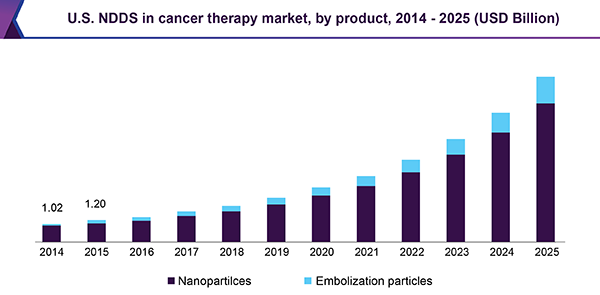According
to a report by Grand View Research, Inc., global novel drug delivery systems(NDDS) in cancer therapy market is anticipated to value USD 26.61 billion by
2025. Growing requirement for advanced medical devices to avail better
treatment is anticipated to propel demand for novel drug delivery systems.
These systems are likely to protect drugs essential for cancer treatment from
enzymatic and chemical degradation.
Growing
need for cancer therapeutic drugs owing to rising cases of cancer is expected
to influence growth of market. Spreading awareness among patients regarding
availability of alternative methods of cancer treatments can stimulate market
growth. Rising cases of cancer owing to
unhealthy lifestyle is anticipated to influence growth of market. Increasing
R&D investments to expand product pipeline and for regulatory approvals of
new products can influence market growth. Supportive reimbursement scenarios in
developed nations coupled with availability of research funding is likely to
augment market growth during the forecast period (2014 to 2025).
Full Research Report On Novel Drug Delivery Systems (NDDS)
Analysis: www.grandviewresearch.com/industry-analysis/novel-drug-delivery-systems-in-cancer-therapy
The
NNDS in cancer therapy market can be segregated on the basis of product and
region. Based on product, the market can be categorized into embolization
particles and nanoparticles. In 2016, nanoparticles segment dominated the
market and accounted of largest market share. It is anticipated to grow at
similar pace during the forecast period. These type of drug delivery systems
are expected to encapsulate various drugs and protect them from enzymatic and chemical
degradation. In addition, they can provide long circulation half-lives,
improved pharmacokinetics and reduced side effects. Moreover, these systems can
also offer enhanced permeability to allow efficient delivery of drugs to cancer
tissues.
Based
on aforementioned properties, nanoparticles can replace conventional
chemotherapy treatment attributed to less risk to healthy tissues and high
efficiency. Nanoparticles can be categorized into micelles, liposomes,
polymers, and other nanoparticles. Micelles and liposomes are likely to be used
for DNA delivery & targeting and can increase drug efficacy. In 2016,
liposomes segment held for largest market share under nanoparticles segment. It
is expected to grow at similar pace during the forecast period.
Browse More Reports Of This Category By Grand View
Research At: www.grandviewresearch.com/industry/medical-devices
On
the contrary, embolization particles segment can be classified further into liquid
emboli, PVA particles, drug eluting beads, and other embolization particles.
These particles can be injected into small vessels providing blood to cancer
cells. Such procedures can allow easy surgical reception of cancer cells
resulting from reduced blood loss.
Regional
segmentation includes Europe, North America, Asia Pacific, Latin America, and
Middle East and Africa. In 2016, North America region dominated the market and
accounted for 36.8% revenue share. Increasing number of research activities to
develop new therapies can fuel growth of market in the region. In addition,
growing awareness availability of novel drugs attributed to promotional and
marketing activities of manufacturers is anticipated to propel market growth.
Moreover, growing budget for novel drug discovery coupled with increasing number
of food and drug administration (FDA) approvals can also fuel market growth in
the region.
On
the contrary, European market followed North America and stood second in terms
of revenue share in 2016. It is expected to witness significant growth during
the forecast period attributed to growing healthcare expenditure. High
prevalence of cancer patients coupled with rise in research funding for cancer
treatments can fuel market growth. Many local organizations in United Kingdom
and Germany are expected to fund new technologies, which in turn can influence
market growth in the region.
In
Asia Pacific, the market is expected to grow at fastest rate during the
forecast period. Rising cases of cancer in China and Japan owing to increasing
geriatric population can stimulate market growth. In addition, increasing
number of research activities coupled with growing awareness regarding
availability of new cancer therapies can augment growth of market in the
region.
Some
of the leading companies offering NNDS in cancer therapy are Merrimack
Pharmaceuticals, Inc.; Teva Pharmaceutical Industries Limited; Johnson &
Johnson Services, Inc.; Samyang Biopharmaceuticals Corporation; and Celgene
Corporation. Geographic expansions, frequent product launches, and distribution
agreements to increase customer base are likely to be key strategies players
can undertake to expand their market share. In addition, companies are likely
to invest in R&D activities to develop new and innovative NDDS systems in
cancer therapy to expand their product portfolio.
Grand View Research, Inc. has segmented the novel drug delivery systems (NDDS) in cancer therapy market on the basis of product and region:
Product Outlook (Revenue, USD Million, 2014 - 2025)
- Nanoparticles
- Liposomes
- Polymers
- Micelles
- Other nanoparticles
- Embolization particles
- PVA particles
- Drug eluting beads
- Liquid emboli
- Other embolization particles
Regional Outlook (Revenue, USD Million, 2014 - 2025)
- North America
- U.S.
- Canada
- Europe
- Germany
- U.K.
- Asia Pacific
- China
- Japan
- Latin America
- Brazil
- Mexico
- Middle East & Africa
- South Africa
About Grand View Research
Grand
View Research, Inc. is a U.S. based market research and consulting company,
registered in the State of California and headquartered in San Francisco. The
company provides syndicated research reports, customized research reports, and
consulting services. To help clients make informed business decisions, we offer
market intelligence studies ensuring relevant and fact-based research across a
range of industries, from technology to chemicals, materials and healthcare.
For more information: www.grandviewresearch.com/

No comments:
Post a Comment